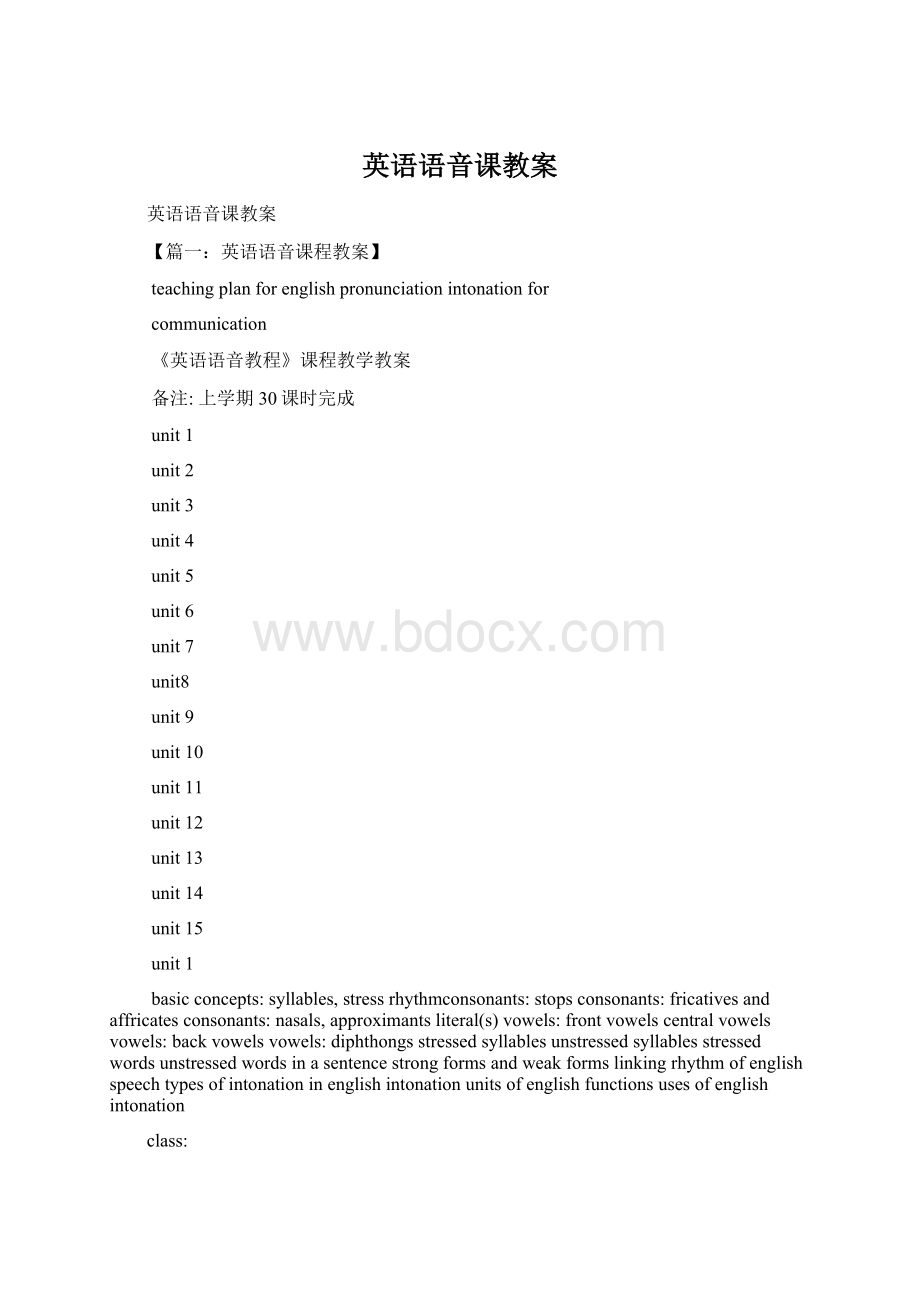 英语语音课教案.docx
英语语音课教案.docx
- 文档编号:8208655
- 上传时间:2023-01-29
- 格式:DOCX
- 页数:11
- 大小:19.22KB
英语语音课教案.docx
《英语语音课教案.docx》由会员分享,可在线阅读,更多相关《英语语音课教案.docx(11页珍藏版)》请在冰豆网上搜索。

英语语音课教案
英语语音课教案
【篇一:
英语语音课程教案】
teachingplanforenglishpronunciationintonationfor
communication
《英语语音教程》课程教学教案
备注:
上学期30课时完成
unit1
unit2
unit3
unit4
unit5
unit6
unit7
unit8
unit9
unit10
unit11
unit12
unit13
unit14
unit15
unit1
basicconcepts:
syllables,stressrhythmconsonants:
stopsconsonants:
fricativesandaffricatesconsonants:
nasals,approximantsliteral(s)vowels:
frontvowelscentralvowelsvowels:
backvowelsvowels:
diphthongsstressedsyllablesunstressedsyllablesstressedwordsunstressedwordsinasentencestrongformsandweakformslinkingrhythmofenglishspeechtypesofintonationinenglishintonationunitsofenglishfunctionsusesofenglishintonation
class:
purpose:
lessonplanbasicconcepts:
syllables,stressrhythm(教案:
附要点、重点和难点)classes1-5grade2008
thestudentswilllearnsomebasicconceptsinenglishpronunciation.wearegoingtolearnsomethingaboutsyllables,stressandrhythminenglish.atthesametime,theywilllearntosaygreetingsandfarewellwithappropriatepronunciationandintonationinenglish.
objectives:
studentswillbeableto:
1.define-intheirownwordsadefinitionfor“syllable”and“stressed
syllable”,thenadefinitionfor“rhythm”and“rhythmicpattern”;
2.compare–basedontheunderstandingofthebasicconcept,comparethe
degreesofstressanddifferentrhythmicpatterns;
3.practice–imitatethetypicalstresspatternsandrhythmicpatternsin
english.
resources/materials:
1.textbook:
wang,guizhen,anenglishpronunciationcourse,higher
educationpress,beijing,2000;
2.handouts:
illustrationofstresspatternsandrhythmicpattern;
3.recordingsofnativespeakers
activitiesandprocedures:
1.beginbyaskingtheclasstofindouthowmuchthestudentsknowaboutstresspatternsandrhythmicpattersinenglish,makesurethatitservesthepurposeofstimulatingthestudentstothinkabouttheissueandhavethedesiretofindouttheanswersthemselves.
2.displayexamplesbyplayingtherecordingofthenativespeakersshowingthetypicalstresspattersandrhythmicpatternsinenglish.
3.askthestudentstolistentothetapestomarkoutthestressedsyllablesinwords.
4.askthestudentstolistentothetapestomarkoutthestressedwordsinsentences.
5.havethestudentsimitatethestresspatternsandrhythmicpatternstoexperiencetherhythminspeech.
6.havethestudentssharewhattheyhavelearnedbyreadingoutthepracticematerialsinpairs.
7.havethestudentslistentotheconversationsrecordedbynativespeakersofenglishandtrytogettherhythmicpatternsintheirspeech.
8.havethestudentspracticetheguidedconversation.askthemtopayspecialattentiontothestresstherhythminspeech.
9.highlightthelanguagefunctionintheconversationinthepractice.
10.haveseveralpairsofthestudentspresenttheirconversationintheclass.
11.commentonthestudents?
performancebyhighlightingtheachievementofthestudentsandtheeffortstheyneedfortheimprovement.
12.askthestudentstodomorepracticeafterclassandgetreadyforpresentationduringthenextsession.
附:
要点、重点和难点
unit1
basicconcepts:
syllables,stressrhythm
inthisunit,wearegoingtolearnsomebasicconceptsinenglishpronunciation.wearegoingtolearnsomethingaboutsyllables,stressandrhythminenglish.atthesametime,wearegoingtolearntosaygreetingsandfarewellwithappropriatepronunciationandintonationinenglish.
firstofall,let?
slookatthesyllableinenglish.
pleaselistentothefollowingword:
driveway.
now,tellme,howmanysyllablesthereareinthisword?
right.therearetwo.pleaselistentothefollowingsentence:
drivehimaway.
tellme,howmanysyllablesthereareinthissentence?
right.therearefour.
introduction
so.whatisasyllable?
asyllableisawordpartandthebasicunitofenglishrhythm.englishwordscanhaveone,two,threeorevenmoresyllables.intheword?
driveway?
therearetwosyllables.inthesentence?
drivehimaway?
therearefour.
whatisastressedsyllable?
inenglishwordswithmorethanonesyllable,oneofthemwillreceivemorestressthantheothers.stressedsyllablesarethosethataremarkedinthedictionaryasstressed.forexample,intheword?
driveway?
thefirstsyllableisastressedsyllablewhilethesecondsyllableisnot.
stressedsyllablesinenglishareusuallylonger,louder,andhigherinpitch.listentothefollowingexample:
thewordbananahas3syllables.syllable1isnotstressedandsoisshort.syllable2isstressedandsoislongwithaclearvowelsound/?
:
/.syllable3isnotstressedandsoisalsoshort.
hereisashortsummaryaboutthestressedandunstressedsyllables:
stressedsyllablesarestrongsyllables.unstressedsyllablesareweaksyllables.stressedsyllables:
-arelong
-haveapitchchange-havefullvowelsounds.unstressedsyllables:
-areshort
-oftenhaveareducedvowelsound.
nowlet?
slookattherhythminenglish.
weallknowthatcorrectpronunciationoftheindividualenglishsoundsisimportantincommunication.thewaythesoundsareorganized,however,isoftenmorecrucialforunderstanding.therhythmofenglish,forexample,isoneofthetwomajororganizingstructuresthatnativespeakersrelyontoprocessspeech.
whatisrhythm?
rhythmcanbefoundeverywhereinlife:
thesoundofaclock,thebeatingoftheheart,thestrokesofaswimmer,andofcourseinpoetryandmusic.butrhythminlanguageislessfamiliarbecauseitislessobvious.therhythmofalanguageischaracterizedbythetimingpatternofsuccessivesyllables.insomelanguages,everysyllableisgivenaboutthesamelength,whileinothers,syllablesvaryinlength.inenglish,strongbeatsarecalledstress--theheartoftherhythmicpattern.
第1单元基本概念:
音节、重音与节奏
本单元将向大家介绍英语语音语调的基本概念,主要介绍英语语音的音节、重音和节奏规律。
首先,让我们先来看看英语的音节:
单词driveway有两个音节。
句子drivehimaway有四个音节。
何谓“音节”?
音节是一个言语单位,常常比一个语音长,但比一个单词短。
一个英语单词可以有一个、两个三个或更多的音节。
就像我们刚看到的单词driveway有两个音节,句子drivehimaway有四个音节。
同时,音节又是英语发音节奏的最基本的单位。
何谓“重读音节”?
如果一个英语单词中拥有两个或两个以上的音节,其中一个音节会比其周围的音节要响亮些。
重读音节通常在词典中有所标注。
例如,单词driveway的第一个音节就是重读音节,而它的第二个音节就是非重读音节。
英语中的重读音节在发音过程中往往要比非重读音节要长一些,响亮一些,同时音调也稍高一些。
例如,“banana”一词有三个音节。
第一个音节是非重音,所以发音所需时间比较短。
第二个音节是重读,所以元音/?
:
/发的比较长,清晰响亮。
第三个音节同样属非重音,所以发音所需时间也很短。
可见,重读音节与非重读音节分别有以下特征:
重读音节:
⒈声音响亮⒉延续时间较长⒊音调较高
非重读音节:
1.延续时间较短2.元音发音弱化
英语话语节奏:
学会发好每一个英语音素,是学好英语语音的基础,正确的发音在语言交流中非常重要。
然而,语音的组合方式对于听者的理解也起着至关重要的作用。
英语的话语节奏就是其中之一。
何谓“英语话语节奏”?
节奏在我们的日常生活中无所不在:
滴答转动的钟表声,砰砰不停的心脏跳动,游泳的划水节拍,优美诗句和音乐的韵律,这些都是节奏的体现。
话语节奏与前面我们所提到的日常生活中显而易见的节奏不同之处在于:
语言中的话语节奏不是那么明显与绝对。
语言中的节奏特征是由一连串音节的长短来体现的。
有一些语言的话语特点是:
每一个音节的音长呈大致相同的趋势,这种音节彼此距离大致相等的现象被称为“以音节定时”节奏。
汉语的话语节奏就有这样的倾向。
例如,当我说:
“面包加牛奶”,这里含5个音节,所需的时间暂且定为5个时段。
如果我要说:
“一片面包加一杯牛奶”,这里含9个音节,所需的时间就是9个时段。
英语的话语节奏则显不同的趋势。
例如,在“breadandmilk”短语中,音节数是三个,其中“bread”与“milk”是重读音节。
在“somebreadandsomemilk”这一短语中,音节数是5个,其中重读的也是“bread”与“milk”。
虽然这两个短语的音节数不同,但是在话语中,它们所需的时间却是大致相同的,因为它们有一个共同点:
重读音节数相同。
这种重读音节彼此距离相等的现象就是“以重音定时”节奏。
掌握这一英语话语的节奏规律。
对于提高我们英语口语的流利程度和自然程度以及英语听力理解快速解码的能力至关重要。
正因为如此,我们将重音与节奏的学习放在中心与突出的位置,从第一单元的概念介绍开始,贯穿整个语音课程学习的始终。
【篇二:
英语语音教案(中英文双解)】
unit1
unit2
unit3
unit4
unit5
unit6
unit7
unit8
unit9
unit10
unit11
unit12
unit13
unit14
unit15
teachingplanforenglishpronunciationpractice《英语语音》课程教学教案basicconcepts:
syllables,stressrhythmconsonants:
stopsconsonants:
fricativesandaffricatesconsonants:
nasals,approximantsliteral(s)vowels:
frontvowelscentralvowelsvowels:
backvowelsvowels:
diphthongsstressedsyllablesunstressedsyllablesstressedwordsunstressedwordsinasentencestrongformsandweakformslinkingrhythmofenglishspeechtypesofintonationinenglishintonationunitsofenglishfunctionsusesofenglishintonation
unit1
lessonplan
basicconcepts:
syllables,stressrhythm
(教案:
附要点、重点和难点)
date:
sept.16-20
class:
classes1,23,grade2002
subject:
englishpronunciationpractice
purpose:
thestudentswilllearnsomebasicconceptsinenglishpronunciation.wearegoingtolearnsomethingaboutsyllables,stressandrhythminenglish.atthesametime,theywilllearntosaygreetingsandfarewellwithappropriatepronunciationandintonationinenglish.
objectives:
studentswillbeableto:
1.define-intheirownwordsadefinitionfor“syllable”and“stressed
syllable”,thenadefinitionfor“rhythm”and“rhythmicpattern”;
2.compare–basedontheunderstandingofthebasicconcept,comparethe
degreesofstressanddifferentrhythmicpatterns;
3.practice–imitatethetypicalstresspatternsandrhythmicpatternsin
english.
resources/materials:
1.textbook:
wang,guizhen,anenglishpronunciationcourse,higher
educationpress,beijing,2000;
2.handouts:
illustrationofstresspatternsandrhythmicpattern;
3.recordingsofnativespeakers
activitiesandprocedures:
1.beginbyaskingtheclasstofindouthowmuchthestudentsknowaboutstresspatternsandrhythmicpattersinenglish,makesurethatitservesthepurposeofstimulatingthestudentstothinkabouttheissueandhavethedesiretofindouttheanswersthemselves.
2.displayexamplesbyplayingtherecordingofthenativespeakersshowingthetypicalstresspattersandrhythmicpatternsinenglish.
3.askthestudentstolistentothetapestomarkoutthestressedsyllablesinwords.
4.askthestudentstolistentothetapestomarkoutthestressedwordsinsentences.
5.havethestudentsimitatethestresspatternsandrhythmicpatternstoexperiencetherhythminspeech.
6.havethestudentssharewhattheyhavelearnedbyreadingoutthepracticematerialsinpairs.
7.havethestudentslistentotheconversationsrecorded
- 配套讲稿:
如PPT文件的首页显示word图标,表示该PPT已包含配套word讲稿。双击word图标可打开word文档。
- 特殊限制:
部分文档作品中含有的国旗、国徽等图片,仅作为作品整体效果示例展示,禁止商用。设计者仅对作品中独创性部分享有著作权。
- 关 键 词:
- 英语 语音 教案
 冰豆网所有资源均是用户自行上传分享,仅供网友学习交流,未经上传用户书面授权,请勿作他用。
冰豆网所有资源均是用户自行上传分享,仅供网友学习交流,未经上传用户书面授权,请勿作他用。


 铝散热器项目年度预算报告.docx
铝散热器项目年度预算报告.docx
